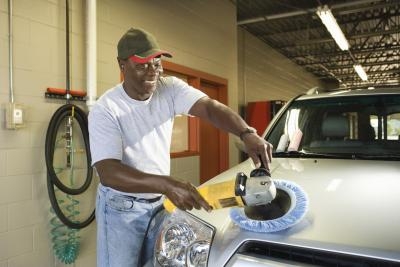
Clear coat lacquer provides a protective covering over base colors on modern passenger vehicles and lends a high gloss finish that makes a car visually appealing. When clear coats are painted, they take up to 30 minutes to dry at low-bake temperatures. Dust circulating around spray booths can sometimes land in the curing lacquer. Once the lacquer is completely dry, imperfections are easy to remove and a perfect finish is achieved using a process called buffing.
Ensure the lacquer is completely cured before removing imperfections. Park the vehicle in a well-lighted area and use a chalk pen to circle dust and other blemishes. Take a bucket of clean water and dampen the auto body panel with a clean sponge. Avoid using dirty water and old sponges; they usually contain grit that can cause scratching once buffing begins.
Wrap a sheet of P2500-grit wet-and-dry paper around the flat area of a rubber sanding block and immerse into the clean water. Place the abrasive side of the wet-and-dry paper onto the auto body panel and move the block in small circles to remove imperfections, using the water as a lubricant. Work on each imperfection individually until all of them are removed. Dry the auto body panel with clean cloth before buffing begins.
Add a foam applicator to the head of the electric polishing machine. Add a small, grape-sized quantity of G3-grade cutting compound to the center of the auto body panel and place the foam applicator over the top of it. Activate the trigger of the polishing machine so the foam applicator begins to rotate and work the compound into the dulled areas of paintwork where imperfections have been removed. Maintain control by adjusting the rotational control switch on the polisher handle to a safe working speed.
Wipe the auto body panel clean of excess cutting compound with a microfiber cloth as soon as shine has been restored. Look across the surface of the panel for swirl marks caused by the cutting compound and add small, pea-sized quantities of glazing compound over the affected areas. Exchange the foam applicator on the polishing machine for a lamb's wool applicator and place onto the surface of the panel.
Activate the switch and work the glazing compound into the swirl marks. Stop the machine regularly and wipe over the panel with a clean microfiber cloth to ensure the marks are being removed. Continue polishing the auto body panel with glazing compound until a perfect, unblemished finish is achieved.